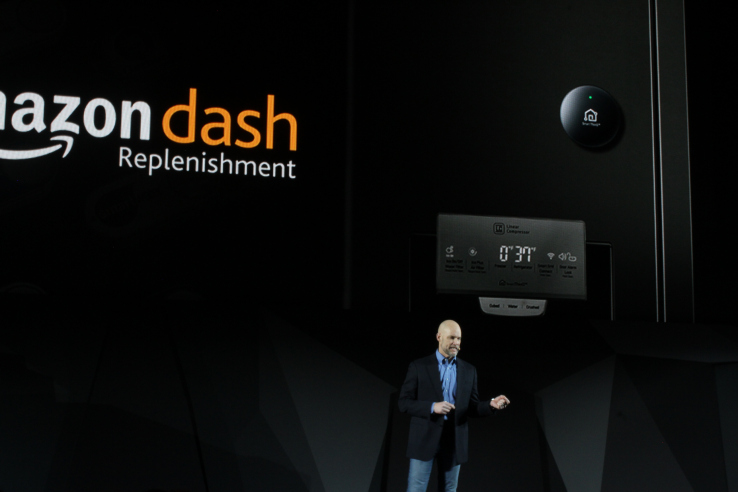

Okay, try not to get too excited: LG today unveiled a smart fridge at a big event ahead of CES in Las Vegas. It has a big touch screen and lets you control a whole host of things — which is fine.
However, the most interesting part here is that the fridge is integrated, along with a whole host of other devices this year, with Alexa. With that, users can tap into Alexa to order food from their fridge. Sounds like a fair enough idea — you’re out of baking soda and you need more, so why not tell your fridge to order some baking soda.
But this is part of a much, much bigger trend at CES this year. Amazon is trying to get Alexa, its voice-powered assistant, into everything. Lenovo has its own Alexa speaker. GE put it in a weird lamp. The point is, Amazon is ready to get this thing into the hands of developers everywhere and just maybe have complete ownership of the voice-controlled interface within a home. We haven’t even gotten onto the CES show floor proper — where we’ll probably see a ton of weird places where Alexa pops up — and it’s already proving to be one of the biggest movements here.
Whether that’s getting Siri in your ear, using Google Assistant on your phone or talking to Alexa in your living room, it’s clear that companies have acknowledged that voice-powered interfaces are going to be the next-generation interface. Amazon has flubbed at hardware before, but it seems to have sparked a new wave of technology with the Echo. And opening up that voice-powered technology to third parties lets everyone else figure out the best new use cases for Alexa, while Amazon focuses on the core technology.
Then, with all that, Amazon can slot those best cases into the Echo proper, and voila: Amazon has the best general-purpose voice interface in your living room, while the rest of the community gets to have a nice number of niche use cases powered by Alexa. Each niche case is probably best set within the environment of their natural use — like ordering food from a fridge — but there’s still a healthy slot for the hub of your voice-controlled home. And it looks like Echo could be the product for that as it discovers the best new use cases.
Starting off with the Amazon Echo, Amazon essentially began a wave of voice-powered home assistants with an increasing number of use cases, with playing music as a good entry point. Since then, Google has tried to fast follow it with its own Google Home product, and each company is trying in some way to flex their voice-assistant AI muscle in order to ensure that they’re the product that users are talking to.
We’re going see more and more partners jump on board the voice interface — and specifically, Alexa — train. And once we get on the floor proper at CES, we’ll probably see what’s going on here at a much, much larger scale. While voice may be a stopgap to getting to AR (or maybe this is what AR in the end looks like), it’s clear that it’s going to be the thing in 2017 where machine learning and VR were the thing in 2016. (Although to be sure, machine learning and VR are still also probably going to be the things this year.)
It’s not going to be long before Amazon faces serious competition, as well. Each company out there has its own proprietary set of data and teams that are handling AI that could make each voice interface both competitive and unique when stacked up against each other. Whether it’s Google Assistant, Cortana, Siri or Alexa, every company is clearly throwing a huge amount of weight behind this form of interface. It may be that we exist with multiple voice interfaces, like Siri on the go and Alexa in your home. But it does mean that there is going to be an initial mad dash to figure out the best initial use cases and get ahead of the competition in those cases.
Adoption for Amazon is going to be key, as well. If it can get Alexa into a number of products that people are already buying, then it can potentially convince them that the Echo is the natural home for the more general use cases. And Amazon can likely figure out some unique ways to monetize its services through its network of Alexa-connected devices. If that works, it gives Amazon a whole new line of business — and revenue — that it can stack on top of its retail business and its increasingly successful cloud services with AWS. Amazon has shown it can pull off perpendicular moves before, and if this strategy of proliferating the technology out to a ton of devices works, it might end up having made yet another strong bet.
And all this is going to be very important going into 2017. Last year, Wall Street adored Amazon as its cloud services business exploded into a very efficient revenue stream that was growing rapidly. This new, perpendicular use case that could turn out to be a successful revenue stream could once again continue to propel Amazon’s shares to new heights. Then, of course, higher shares means less pressure from investors and an additional way to woo the best talent — which then could continue to work on Alexa and improve it even more.
Be sure to follow the rest of our coverage at CES this year, where we’re bound to see a whole lot of weird Alexa going on for the next few days.

